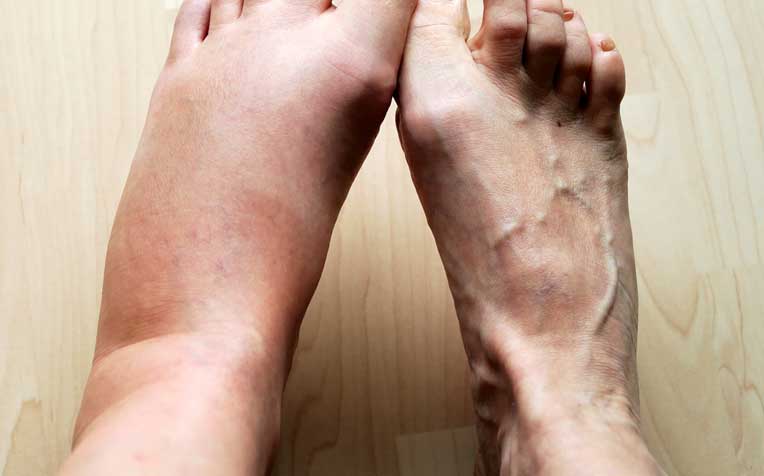
Lymphoedema can occur on your legs and arms, including your fingers or toes.
Lymphoedema (Lymphatic fluid build-up) in its early stages can be reversed with massage and therapy
Women who undergo surgery to remove cancerous tumours of the breast can sometimes later find one arm to be larger than the other. It’s not a procedure gone wrong. Rather, when surrounding lymph nodes are removed as part of treatment, normal lymphatic fluid drainage is interrupted. This then leads to fluid build-up, causing the affected area to swell over time. However, the condition known as lymphoedema can be reversed easily when treated in its early stages, said Ms Kou Seow Wei, Principal Physiotherapist, Singapore General Hospital (SGH), a member of the SingHealth group.
“We use a massage technique known as manual lymphatic drainage, in which very light, gentle strokes stretch the patient’s skin to stimulate the lymphatic flows from the affected area,” Kou said.
“We try to redirect the flow to another area that’s not affected, to other lymph nodes that can be drained.” Usually, this is accompanied by compression bandaging to apply external pressure to the swelling. New patients usually have to undergo two weeks of daily therapy lasting an hour each time, after which follow-up therapy is arranged on a less frequent schedule such as fortnightly, monthly or longer. Patients will have to wear compression sleeves or arm stockings for life-long maintenance.
Lymphoedema can occur after cancer surgery
Lymphoedema can occur when the lymph vessels or nodes are poorly developed, in a rare, inherited condition known as primary lymphoedema. Most patients have the secondary form of the disease, which occurs when surgery, cancer treatments like radiotherapy, disease, or infection damage the nodes or vessels. The lymphatic system circulates protein-rich lymphatic fluids throughout the body, collecting and filtering out bacteria, viruses and waste products from the body.
“It’s a kind of a waste disposal system,” said Ms Kou.
Patients who undergo cancer surgery are taught to recognise the signs of lymphoedema. But the condition has few other symptoms apart from swelling and a feeling of discomfort, so patients often don’t realise they have it until friends or family members point the anomaly out to them. Also, lymphoedema can develop suddenly and very quickly. The affected leg or arm of most of the patients that Ms Kou sees is usually twice the size of the other, although in extreme cases the condition can lead to swelling of monstrous proportions. Manual lymphatic drainage is effective in bringing the swelling down, after which excess tissue can be surgically removed if needed.
Symptoms of lymphoedema:
- A feeling of heaviness of tightness
- Swelling of part or all of your leg or arm including fingers or toes
- Difficulty moving
- Aching or discomfort
- Skin hardness and tightness
- Folds developing on the skin
How to care for your skin when you have lymphoedema
Patients are taught to clean and moisturise their skin properly to avoid inflammation and infection, and to do light exercise to improve lymph drainage.
“Elevation of the limb helps with the swelling, and so does exercise. You need to engage in activities where there’s muscle contraction, to help with the lymphatic flow,” said Ms Kou. “The swelling can hinder your daily activities because your arms or legs are bigger. You may not be able to walk for long, or be able to carry things. And you may get tired easily,” she added. Ms Kou said that SGH receives about 140 new lymphoedema cases a year.
Lymphoedema treatment options
While the condition is not life threatening, it can lead to infections and complications, amputation of the affected limb, or even death. For more severe cases, surgery is an option. Surgeons can create new channels for proper drainage through lymphatic-venous anastomosis or lymph node transplant. Lymphoedema can occur anywhere, but it most commonly affects the legs and arms, as lymph nodes are removed during breast, prostate, gynaecological, and head and neck cancer surgeries, disrupting lymph drainage in these areas. If the condition progresses without treatment, tissues in the affected area become increasingly swollen and thickened.
Ref: O17
Contributed by
















 Get it on Google Play
Get it on Google Play